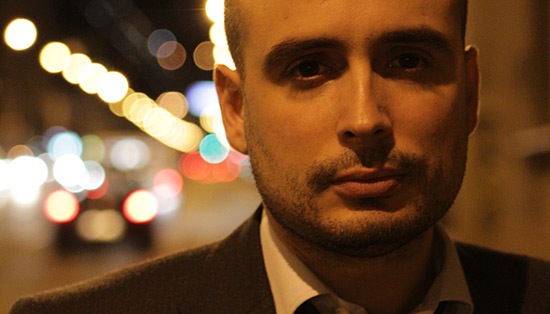Photograph courtesy of Marek Szold
It’s the early morning of Good Friday and central London is strange and deserted, devoid of not just life but, more importantly, a suitable venue to sit down for some tea. Peter Strickland should really be putting the finishing touches to his upcoming third feature film Duke of Burgundy, set for release later this year, but instead, we’re wandering the streets, thirsty and tired, but eager to discuss record labels, specifically Peripheral Conserve, the boutique label which has been run by Strickland since 1999.
Inspired by the likes of Wurlitzer Jukebox and Duophonic, Peripheral Conserve initially released music from Strickland’s own musical outfit, The Sonic Catering Band (an unlikely but often delicious calibration of sonic experimentalism and culinary expertise; sample song titles: ‘White Light From An Oven Above’, ‘Kitchen Utensil Ploy’), but soon branched out into releasing beautifully packaged 7"s and 12"s from the likes of erstwhile Broadcast man Roj Stevens, the improvised grotesque-ness of the Bohman Brothers and, now, Wasp Boutique, an unholy collision between Art-Errorist (also known as Faust’s Jean-Hervé Péron) and Zsolt Sőrés.
Of course, anyone familiar with Strickland’s work thus far will be aware of the staggering amount of direct and indirect musical influences on every aspect of his filmic craft; listen to the cracked birdsongs of Nurse With Wound’s ‘Ciconia’ as it dazzles and spirals amid the amorphous moral topography of Transylvania in Katalin Varga, or the astonishingly vivid giallo and foley sounds constructed and deconstructed by Broadcast for the Berberian Sound Studio, each one a teasing, sonic apparition of psychological intensity. In fact, Nurse With Wound’s Steven Stapleton designed the wonderfully bizarre artwork for the Wasp Boutique, a release which came about through a chance encounter in a Hungarian venue between a bunch of lost and priapic students and a chainsaw. "I went to see Art-Errorist and Sőrés in concert in Budapest in 2011," reflects Strickland in the empty basement of a Wardour Street eatery when we finally settle down. "The venue was accidentally double-booked with a student disco and twenty or so minutes into the Art-Errorist/Sőrés concert, the place was besieged with a throng of horny young men ready to impress members of the opposite sex with their moves on the dance floor. Messrs Péron and Sőrés were having none of it and abruptly ended the concert. Jean-Hervé could be relied on to take the protest a step further by chasing the most unruly students out of the venue with his chainsaw. After witnessing the chaos, I begged both men if I could release something by them and almost three years later, here we are."
Considering the huge part in which music has played a part in Strickland’s personal and professional lives, it seemed fitting to turn the conversation into a Baker’s Dozen piece in honour of Peripheral Conserve’s imminent re-activation after a brief hiatus. Wasp Boutique is the twenty-second release on the label. "The plan is to go up to 25 on the label and then take a breather," Strickland says. "Usual reasons: no space to store stuff, too expensive and time-consuming. The temptation is to stop, but I learnt my lesson when I did that last time in 2004. The chances are I’ll miss it too much and start again at some point, but I need to start saving money if I want to return to the UK. There are three more releases planned: Cavern Of Anti-Matter [Tim Gane from Stereolab’s new band], Jean-Michel Van Schouwburg and then something or other…"
Apart from a couple of totemic choices from the canon of musical influences, Strickland’s thirteen albums range from the odd to the downright outré, with a little bit of high camp thrown in for good measure. More importantly, his recollections are filled with personal insight, factual precision and an unlikely cavalcade of characters, not least Jason Pierce and Sonic Boom reimagined as Hollywood’s Golden Couple, a gay porno with the magnificent working title Gang Of Four Skins, and the sounds of Bowie’s Low as if it were recorded in Humberside.
Wasp Boutique is out now on Peripheral Conserve. Click on his image below to begin scrolling through Peter’s choices


